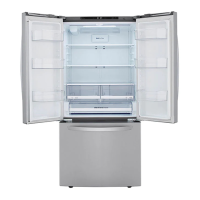39SMART FUNCTIONS
ENGLISH
This equipment should be installed and operated
with a minimum distance of 20 cm (7.8 inches)
between the antenna and your body.
NOTE
• THE MANUFACTURER IS NOT RESPONSIBLE FOR
ANY RADIO OR TV INTERFERENCE CAUSED BY
UNAUTHORIZED MODIFICATIONS TO THIS
EQUIPMENT. SUCH MODIFICATIONS COULD
VOID THE USER’S AUTHORITY TO OPERATE THE
EQUIPMENT.
Open Source Software Notice
Information
To obtain the source code under GPL, LGPL, MPL,
and other open source licenses, that is contained
in this product, please visit http://
opensource.lge.com. In addition to the source
code, all referred license terms, warranty
disclaimers and copyright notices are available for
download.
LG Electronics will also provide open source code
to you on CD-ROM for a charge covering the cost
of performing such distribution (such as the cost of
media, shipping, and handling) upon email
request to opensource@lge.com. This offer is valid
for a period of three years after our last shipment
of this product. This offer is valid to anyone in
receipt of this information.
Smart Grid Function
When the refrigerator operates in Smart Grid
mode, the Smart Refrigerator function can control
energy usage or delay the operation of some
functions to save energy during peak usage
periods.
• You can override the Smart Grid function any
time (using the Smart Grid button or
application).
• To use the Smart Grid function, you need to
register your appliance with your electric utility
company.
Smart Grid Application Features
• Smart Saving_Demand Response
- You can lower energy usage based on Demand
Response (DR) signals from the utility
company. If the refrigerator is operating in
Smart Saving mode according to the DR signal,
you can see a pop up.
• Seasonal Energy Savings
- Lower energy usage based on time period.
Using the Smart Grid Function
This feature responds to notification events from
your utility company to run high energy
consuming tasks during off-peak periods when
demand is lower. These notification events are
known as Demand Response signals.
If the refrigerator receives a Demand Response
signal from the utility company, the refrigerator
will turn on the Grid LED on the refrigerator
display and control its power consumption
according to the signal. The refrigerator will
respond to the signals received from the utility
company as long as product performance is
maintained.
If the refrigerator receives a Demand Response
signal, the refrigerator will operate in Delay
Appliance Load (DAL) or Temporary Appliance
Load Reduction (TALR) mode.
Delay Appliance Load (DAL)
The refrigerator responds to a DAL signal by
providing a moderate load reduction for the
duration of the delay period.
This mode controls functions that consume a lot of
energy such as adjusting the cooling system,
running the defrost cycle, and making ice.
• When the refrigerator operates in DAL mode,
the Grid LED is illuminated on the refrigerator
display.
• DAL mode is automatically deactivated after the
period stipulated by the DAL signal (max. 4
hours) or when you override the Smart Grid
function.
Temporary Appliance Load Reduction
(TALR)
The refrigerator responds to a TALR signal by
aggressively reducing the load for a short time
period, typically 10 minutes. This mode reduces
energy consumption by stopping the compressor
and controlling the functions that consume a lot of
energy such as the defrost cycle and fan.
• When the refrigerator operates in TALR mode,
the Grid LED is illuminated on the refrigerator
display.
• TALR mode is automatically deactivated after the
received duration (max. 10 minutes), or when
you override the Smart Grid function. The mode
is immediately deactivated and the refrigerator

